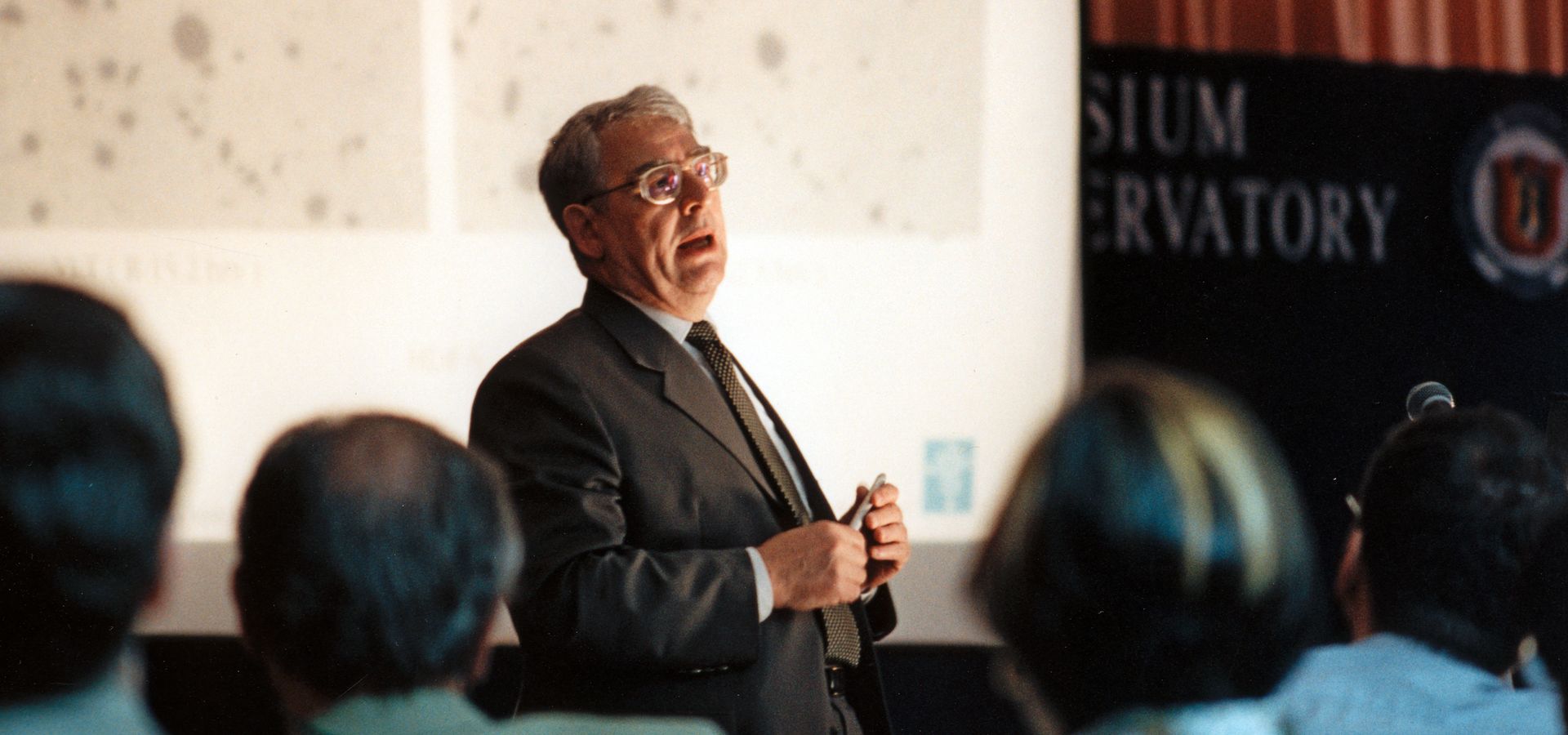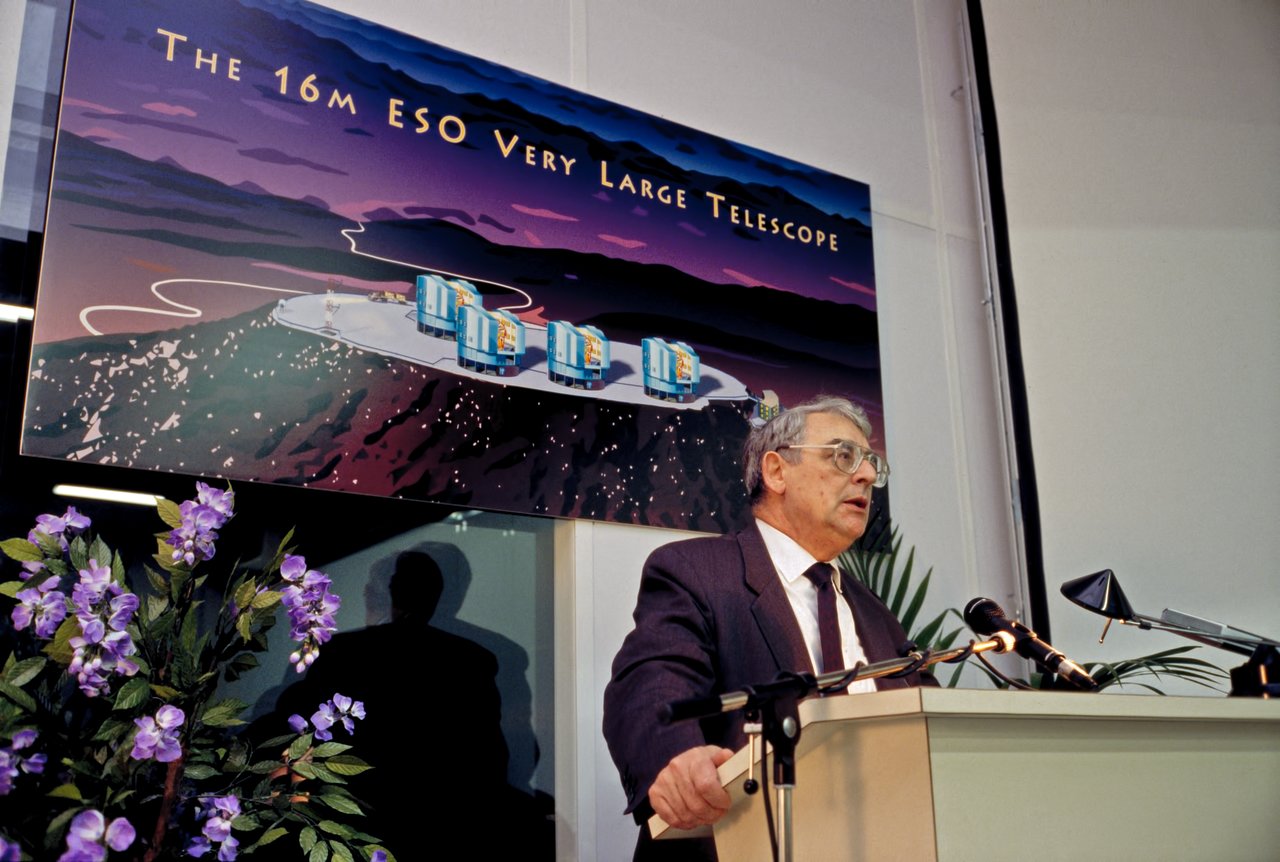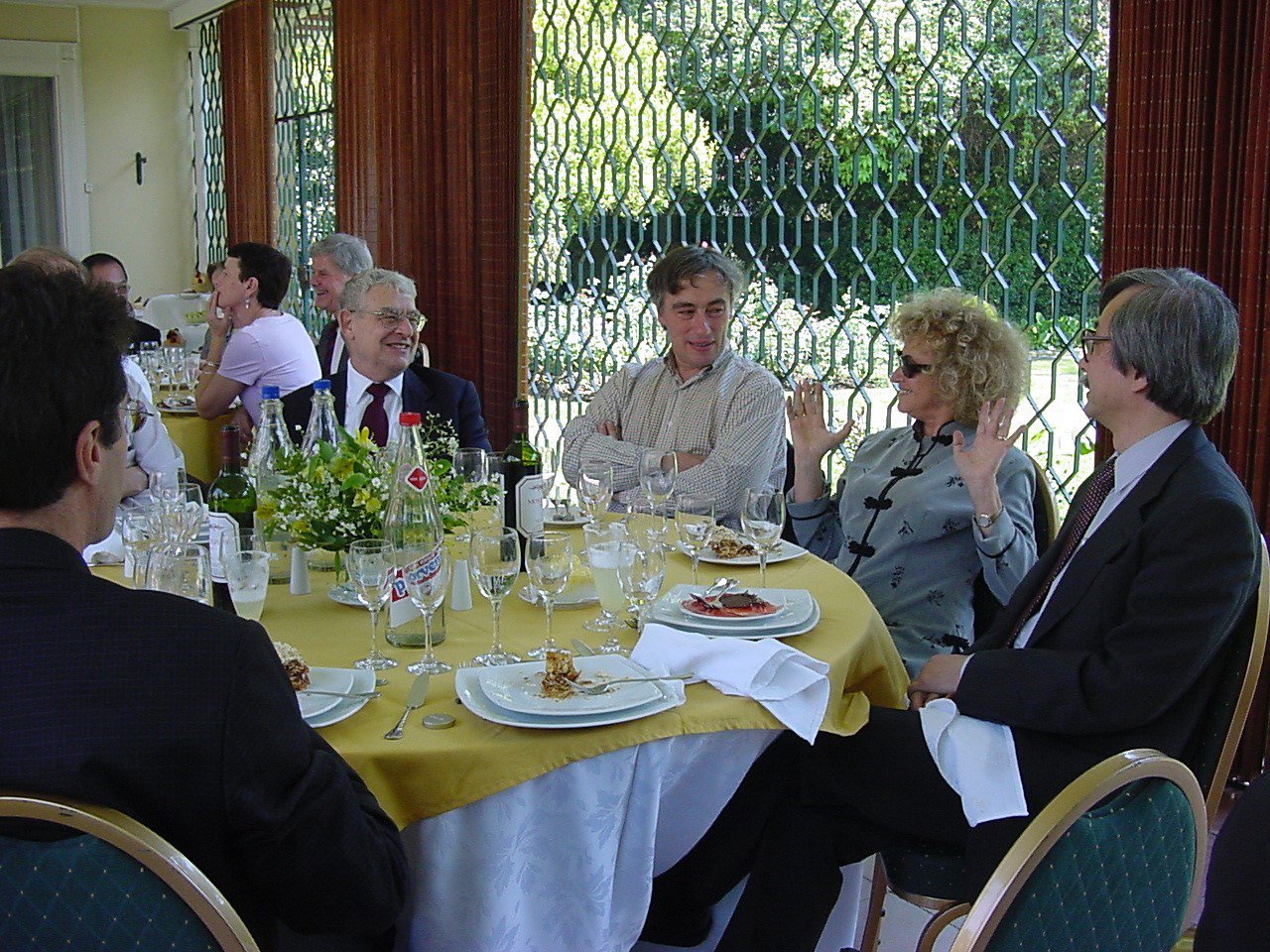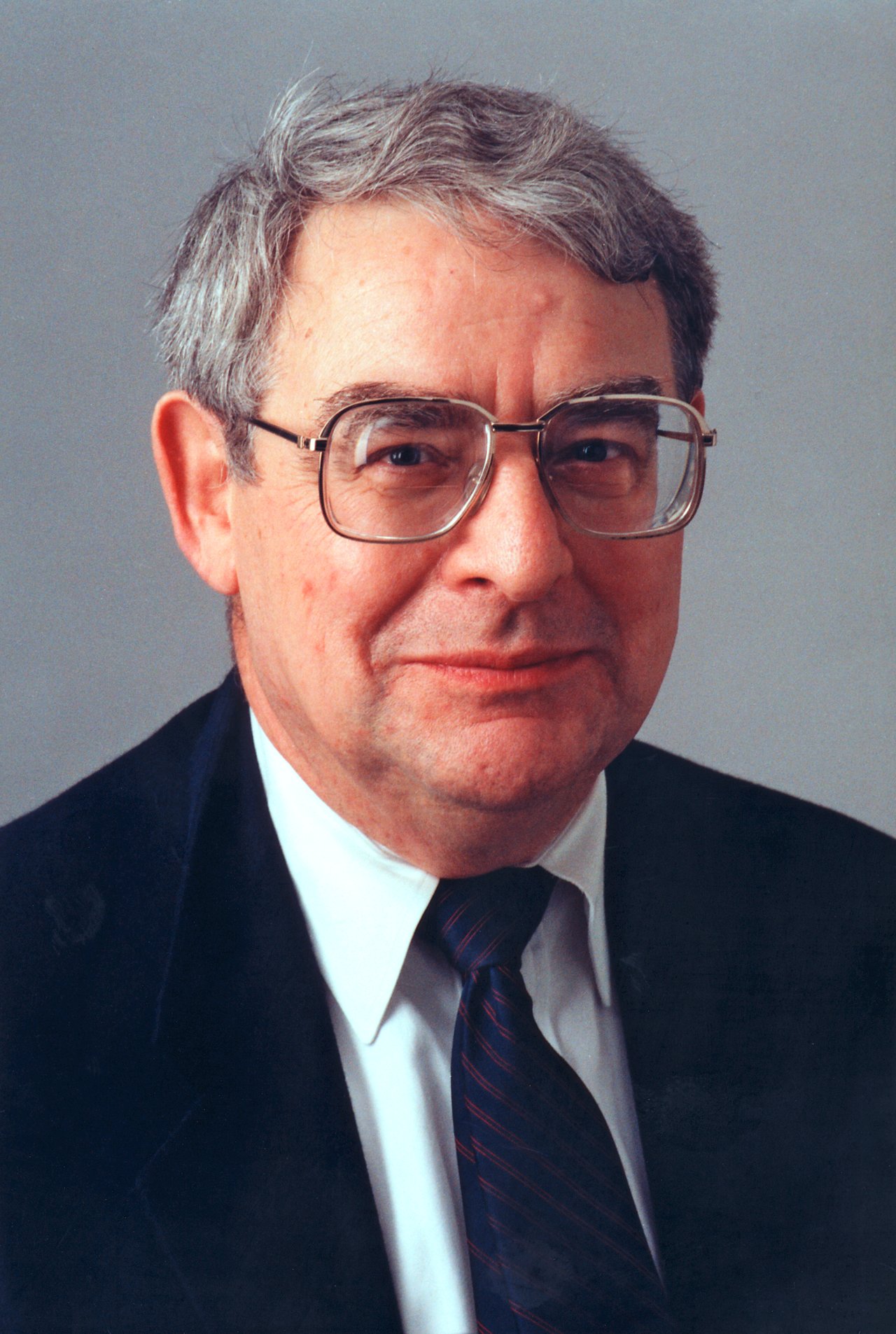- What made former ESO Director General, Riccardo Giacconi, a legend in the world of X-ray astronomy
- How Giacconi was instrumental in the success of the Very Large Telescope
Catapulted from Padova to Baltimore
Two unforgettable events in ESO’s history
The budding X-ray astronomers club
---
Piacere, Riccardo Giacconi
Nando Patat, Head of the Observing Programmes Office, ESO
Former ESO Student, 1994-1996
It must have been April 1994 and I had just joined ESO as a PhD student, working with John Danziger. My command of English was rather poor, and I remember I felt very intimidated. It was a Friday late afternoon. In the corridor of the fifth floor I crossed paths with a man and I had no idea who he was. He was clearly looking for somebody. The words buona sera (good evening) came out of my mouth spontaneously.
He stopped and looked at me quizzically, "Come buona sera?" (What do you mean buona sera?) I immediately realised my mistake in addressing somebody in my mother tongue and felt ashamed, but at the same time I noticed that the question had been uttered by a native in the same language. I had no time to take any action: his hand was already shaking mine, his eyes piercing mine.
"Piacere, Riccardo Giacconi." (I'm Riccardo Giacconi, a pleasure to meet you).
That night I went home convinced that I had no future in this organisation.
---
Catapulted from Padova to Baltimore
Paolo Padovani, ESO ELT Astronomer
STScI Montedison Fellow between 1987-1990
It was thanks to Riccardo that I got my first fellowship. Riccardo was on the board of the research institute of Montedison, an Italian chemical company that was interested in supporting science. Riccardo managed to convince Montedison to sponsor a fellowship for a young Italian astronomer to spend two years at the Space Telescope Science Institute (STScI) in Baltimore. I was selected and that changed my life as I found myself catapulted from Padova to Baltimore!
Riccardo was an amazing person: apart from his scientific stature, which is well known, he was a gifted painter — his copies of famous paintings were impressive — and an avid reader who possessed a huge library. Despite appearances, he was a shy person who had a tendency to get nervous every time he had to give a presentation, even as STScI director. I still remember the “Italian evenings” at his house in Baltimore and the many chats we had at the ESO guesthouse when he was ESO Director General and I was on my way to observe at La Silla. While talking to him, one could actually feel the depth of his knowledge across many branches of astronomy.
---
Ensuring La Silla’s legacy
Ueli Weilenmann, Former Deputy Director of Paranal
Head of Infrared Instrumentation at La Silla, 1996-2004
We owe it to Riccardo Giacconi that the ESO 3.6-metre telescope at La Silla is still producing great science. Thanks to his decisiveness many years ago, this installation is, together with the HARPS instrument, one of the most successful exoplanet hunters, and will enjoy many years of productive life to come.
When I presented the upgrade project for the ESO 3.6-metre telescope at the ESO-wide review in 1995, the Director General was sitting in the second row of the auditorium and followed my presentation with interest.
I believe that he could not really embrace Luca Pasquini's and my idea to spend 2 815 000 Deutsche Marks for this upgrade while the Very Large Telescope (VLT) was in full development. We had to reduce our scope a bit so we could get the green light from ESO’s Scientific Technical Committee later in 1995. At the same time, work was initiated at La Silla to develop a proprietary telescope control system. This was in contrast to my idea to apply full VLT standards and get recommendations and support from our Garching colleagues who were already working full throttle on the VLT.
At one of his subsequent regular visits to La Silla as Director General, we met Riccardo for a review meeting, and he made the point of saying that the 3.6-metre upgrade should either apply VLT standards or the project was doomed. Following a decisive thump on the table on his part we duly followed suit and went the VLT way. This was a happy moment for me as project manager. Assured by the support of the Director General and with the dedication of ESO staff, we made the project a success!
---
Two unforgettable events in ESO’s history
Dietrich Baade, Former Deputy Director for Science
Astronomer, NTT Upgrade Project
Two events made Riccardo Giacconi a legend in his first months at ESO:
- Riccardo’s term as Director General started on 1 January 1993. Between 2–4 January he held the first ESO Review, which means he governed the proceedings from the beginning through to the end. Every topic relevant to ESO was presented by the staff member responsible, from administration through to the VLT project, nothing was left out. Riccardo had invited three consultants from the US. On the first day, they were quite active. On the second day, they were somewhat worn out, and the third day saw them almost hanging in their chairs. But Riccardo was unimaginably well prepared and fired up, question after question without fatigue. Not only did he fully understand what people were talking about, he also knew what they had skipped over — and even, it seemed, for what reason. The prospects of being examined by their new Director General without a warm-up phase on both sides made some speakers nervous; over the course of the review, when speakers realised how extremely focused Riccardo’s questions were, one could occasionally see hands tremble and hear voices shake. This would not change much during the years to come.
- Given this introduction, everyone was surprised that Riccardo himself did not seem to be keen to present himself to his new staff. Finally, in March or April, he gave in to requests from the Staff Committee and convened the first all-hands meeting. ESO’s biggest concern at that time was whether it would be permitted to use Cerro Paranal as the site of the VLT. The project was hampered due to conflicts about land ownership to such an extent that ESO did not even know which parties should be involved in the contract for the right to erect the observatory at Paranal. Riccardo addressed this issue almost right at the beginning of the speech to the organisation, delivered with just a few handwritten notes. He said: “Let me tell you what I told the staff at the Space Telescope Science Institute that was in a similar situation after the Challenger disaster” — the space shuttle had exploded soon after the launch, and for quite some time it was unknown if and when the usage of the other three space shuttles would be resumed. He continued, “We should not get obsessed with the idea of supporting this Hubble Space Telescope (HST). Of course, we do want to operate HST. However, our much bigger goal must it be to establish ourselves as the centre of excellence that no one can ignore whenever the operation of an astronomical space project of similar relevance needs to be managed.” — it was for this reason that Riccardo had resisted suggestions that the STScI be called the Hubble Space Telescope Science Institute. “In the same sense, we at ESO should not be obsessed with this specific VLT and Paranal. Whilst we will try as hard as possible to make this observatory a reality and a success, our real objective must be that whenever a similar project is discussed, no one will think of doing it without ESO.”
Such a simple and convincing description of ESO’s endeavour had not been heard before. Riccardo also addressed how this goal should be achieved, simply stating: “Procedures, procedures, procedures.” In fact, many of the procedures in effect at ESO today have their roots in what one might call Riccardo’s second commandment. The first being the “primacy of science”, a proclamation he renewed at every possible opportunity.
---
The budding X-ray astronomers club
Harry van der Laan, Emeritus Professor University of Utrecht & University of Leiden
(ESO Director General 1988–1992)
In the autumn of 1964 I met Riccardo in Chicago at a meeting of the High Energy Division of the American Astronomical Society, which he had organised; this was the first time I interacted with the budding X-ray astronomers’ club. I particularly remember that Churchill had died the morning that I came home to London, Ontario.
That interaction intensified when I initiated a collaboration of my group at Leiden Observatory with Riccardo’s group at the Harvard Smithsonian Center for Astrophysics — we called this RADEX, prompted by the fact that the fields of view of the two instruments on HEAO II (later called the Einstein Observatory) matched those of the Westerbork Synthesis Radio Telescope at 21 and 6 cm. It was clear to me from the start that non-thermal radio sources and X-ray sources were astrophysically related (analogous to smoke and fire). Several of my PhD students profited from RADEX. In 1974 when I was on sabbatical at the Institute for Advanced Study in Princeton we discussed overlapping issues again. At that stage, neither of us could have imagined we were destined to become successive Directors General of ESO.
---
“I respectfully disagree!”
Catherine Cesarsky, Haut Conseiller Scientifique, CEA Saclay
(ESO Director General 1999–2007)
I met Riccardo very early in my career, in 1969, when I was a graduate student at Harvard and he was involved with successful X-ray experiments at American Science and Engineering. He was interested in the work I was doing on cosmic rays and that is what led to our first conversations. After that, through working mostly in high energy astrophysics until 1984, I had plenty of opportunities to meet him, hear his talks at meetings and occasionally discuss with him.
We shared an IAU Commission from 1982 to 1985, with Riccardo as president and I as vice-president. Later, I was part of a visiting committee at the STScI when he was Director and I had the opportunity to witness the effectiveness of his leadership. In 1992, I was a member of the ESO Director General search committee, which Emilio Picasso chaired. I strongly supported the selection of Riccardo Giacconi. He arrived in 1993 and promptly reorganised ESO, moulding it into the best possible shape to build the VLT, also bringing in experts from the US. I followed this work closely over the first years, as I was Council member and even Council Vice President for a period. In that capacity, I participated in his first meeting with President Eduardo Frei in Santiago, in 1994, to attempt to unlock the issue of land ownership of Paranal. Riccardo was excellent in these diplomatic endeavours, he projected a figure of strength and straightforwardness which inspired confidence.
In 1995 I was too busy with other duties in France and left the ESO Council and Riccardo promptly convinced me to join the ESO Visiting Committee. I thus had the opportunity twice to survey ESO’s development under Riccardo, particularly the construction of the VLT. We admired the space-inspired processes he was applying to the construction, and his foresight in organising data management along the lines followed by HST. I can still hear him saying: “On ground, the contingency is time”, but he put every effort in minimising delays in the completion of the project. I vividly remember his satisfaction with the VLT inauguration in Paranal in March 1999 — one of the greatest days of ESO history.
We had a very friendly meeting during the handover of responsibility for ESO before he left Germany. I still have my handwritten notes from this meeting. In subsequent years, we met regularly at ALMA Board meetings, where he was part of the North American delegation and I of the European one. We broadly agreed on all the important issues, for example, practically every detail of our first bilateral ALMA plan — on the governance, on enhancing the power of the ALMA central team, and even on the choice of the leaders we put in place. But we frequently had disagreements on several lesser issues, he would often say to me, “I respectfully disagree!”
My perception was that once in the US, as president of the Associate Universities, Inc. (AUI), he would have liked the US to take the lead in the Atacama Large Millimeter/Submillimeter Array (ALMA) (in fact, he said that to me many times), and found it difficult to accommodate a partnership on equal terms between AUI-NSF and ESO. However, I am sure we were equally happy at the time of ALMA inauguration in 2013; though unfortunately, Riccardo was not in Chile for the event.
Our personal relationship remained cordial through this entire period. I particularly remember that when he obtained the Nobel Prize, in 2002, we found ourselves in Santiago at the same time and he invited me to an excellent restaurant for dinner, and we both had a great time! After Riccardo stopped chairing the AUI in 2004, I had fewer opportunities to see him. I think the last time was in Munich, he had come with his wife, Mirella, in 2006 or 2007. He did not particularly like to delve into reminiscences, and refused to go to the ESO Headquarters or to the apartment where he lived in Munich, which I rented after his departure. We did however exchange personal Christmas cards for several years — long after I had left ESO. I have on my wall in Paris the copy of a picture by Max Coyer, which he had made and given to me (see below). It makes me very sad indeed to think he is not with us anymore, but it is comforting to remember how interesting and successful his professional life has been. He will remain one of the great astrophysicists of the 20th century.
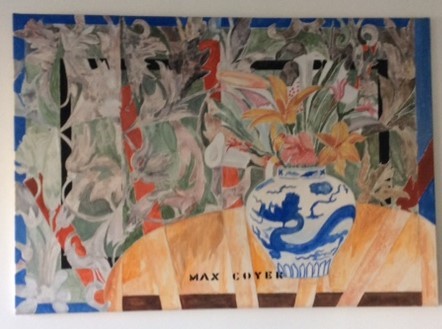
---
X-ray legend
Xavier Barcons, ESO Director General (2017–)
The name “Riccardo Giacconi” came up early on in my career, around the early 1980s, when I was working on models for the cosmic X-ray background (XRB) based on radiation from a tenuous but very hot intergalactic medium. It was Riccardo and his colleagues who had discovered the XRB in 1962, along with the first extrasolar X-ray source, Scorpius X-1. Riccardo and his team were conducting the first deep surveys with X-ray imaging telescopes (particularly the Einstein Observatory), showing that a sizeable fraction of the soft XRB could be resolved into point sources, most of which turned out to be Quasi-Stellar Objects. Subsequent work with powerful X-ray telescopes and optical follow-up proved him right and our models irrelevant.
Everyone working in X-ray astronomy, including myself, considers Riccardo the person who started X-ray astronomy and made it flourish. In his mind, X-ray observations were only one more (rather critical) way of doing astronomy, so he pushed in his usual forceful way for the best angular resolution in X-ray imaging telescopes. The current NASA X-ray observatory workhorse, Chandra, with an on-axis angular resolution of less than one arcsecond was the ultimate result of his push into this territory. Not only did he initiate X-ray astronomy, but he also managed to give it a very central role in astrophysics. He was a passionate promoter of multi-wavelength deep surveys and, joining his Chandra and ESO roles, he laid the groundwork for the Chandra Deep Field South.
After his enormously fruitful career at longer wavelengths (at ESO with the VLT, later with ALMA, and also at Associated Universities Inc.), Riccardo actively supported the concept of a wide-field X-ray telescope, capable of surveying large patches of the sky at sufficient depths. He was never comfortable to merely be the “father of X-ray astronomy”, but instead he took part in debates among different concepts and ideas for next generation X-ray observatories.
It honours me enormously to be his successor as ESO Director General. The current shape of the organisation is a tribute to all the people who have worked at ESO, and most notably the former DGs. Riccardo left a very important legacy to ESO, especially in the way that projects are conducted, the scientific drive behind them, and how the organisation is aligned to achieve them.
Numbers in this article
| 1962 | Year that Giacconi and colleagues discovered the first extrasolar X-ray source and the cosmic X-ray background |
| 1964 | Year that Harry van der Laan met Giacconi in Chicago at a meeting of the High Energy Division of the American Astronomical Society |
| 1969 | Year that Catherine Cesarsky first chatted to Giacconi, about cosmic rays |
| 1974 | Year that Harry van der Laan met Giacconi for a second time and discussed overlapping issues at the Institute for Advanced Study in Princeton |
| 1993 | Year that Giacconi became ESO Director General |
| 1994 | Year that Nando Patat crossed paths with Giacconi in the corridor |
| 1995 | Year that Ueli Weilenmann presented the upgrade project for the ESO 3.6-metre telescope at the ESO-wide review |
| 1999 | Year that Giacconi left ESO |
| 2002 | Year that Giacconi won the Nobel Prize in Physics for “pioneering contributions to astrophysics, which have led to the discovery of cosmic X-ray sources" |
| 2013 | Year that ALMA was inaugurated |

